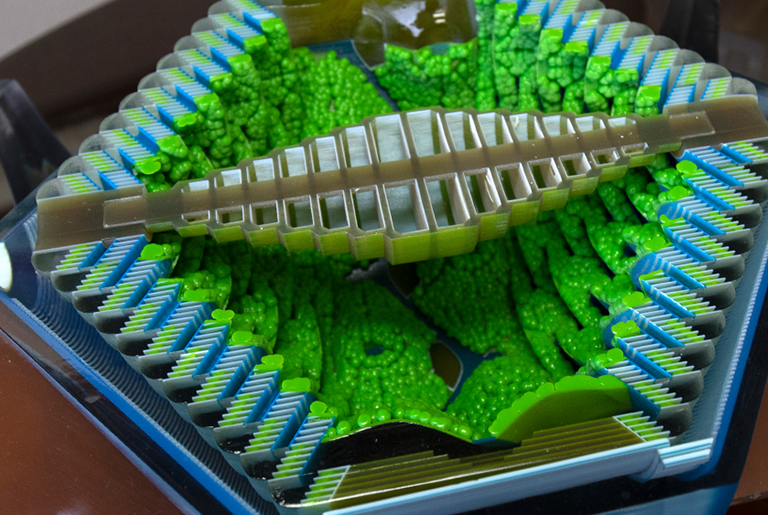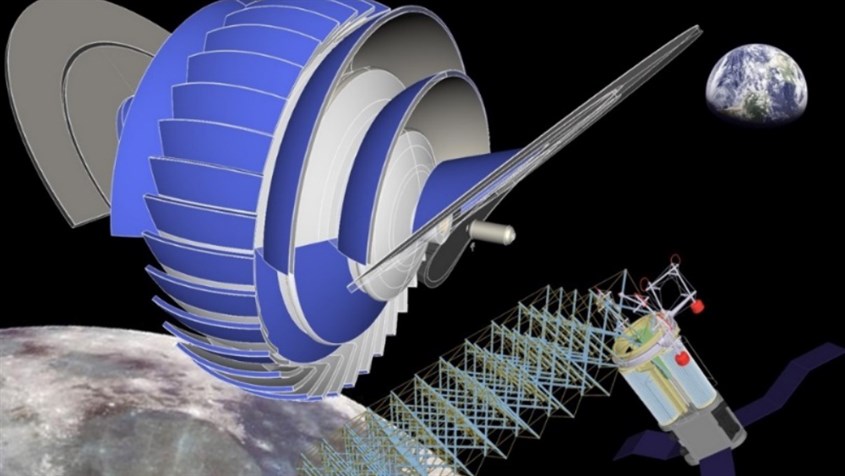
As NASA and private companies race to send humans to Mars and beyond, the need for a program providing sustainable life for long periods in space becomes apparent. Dr. Robert Skelton has proposed a growable habitat with 1 G of gravitational force to solve this need.
Skelton, a TEES Eminent Professor in the Department of Aerospace Engineering at Texas A&M University, is wrapping up Phase II of his space habitat project funded through NASA’s Innovative Advanced Concepts Program.
Skelton aims to answer four yet-unsolved needs for maintaining long-term life in space: gravity, radiation protection, agricultural space for food production, and a growable technology for expanding the habitat as economic conditions allow.
While humans have been traveling to space for over 50 years, each of the stays has been relatively short, in part because outer space is not a friendly long-term environment for humans. The human body is used to a 1 G gravity environment as found on Earth. When astronauts spend a significant amount of time in zero gravity, different bodily systems are affected, including bone density loss, impaired vision, muscle atrophy, cardiovascular deconditioning and immune system changes.
For example, on Earth, the fluid pressure in your eye is less than the pressure in your feet, because gravity is pulling everything down. When someone is in space, the pressure is the same throughout the body, which is too much for the eye. The pressure change causes changes to the eye that are noticeable upon return to Earth.
Skelton argues that the only way to sustain life in space long term is to provide a habitat for humans that provides a gravity environment similar to what they experience on Earth. The habitat he envisions is a settlement in space with research capabilities to determine what level of gravity is required for human health before launching long-term space travel to Mars and farther.
He proposes to start the habitat at the size of 20 meters radius, enough to sustain about 20 people, with the final structure being built over time out to 225 meters, housing 8,000 people with 300 square meters of agricultural space per person.
The initial habitat would be small and built from materials launched from Earth. Because material resources are costly in space, Skelton suggests using tensegrity systems for the design of the growth adaptable space structure. These minimal mass structures make the habitat easy to change in shape, and it’s very strong and lightweight. Subsequent growth stages of the habitat would rely on tensegrity robots mining materials from the moon and asteroids.
With the overall shape of the habitat designed in concentric cylinders, the outer shell would be a thick-wall of regolith for radiation protection that would rotate slowly to enhance stability. Regolith is a layer of loose, heterogeneous superficial deposits covering solid rock found on Earth, the moon and asteroids. The habitat inside would spin at a faster rate to provide artificial gravity (due to the centrifugal forces) for the inhabitants inside. The habitat would provide all levels of gravity from 0 G to 1 G where the lower g-level space is reserved for agriculture and the people occupy higher G-levels up to 1 G.
The outer shell would consist of 5 meter thick panels, which would allow light in, but are thick enough for radiation protection. Included in the outer shell are shutters that can open and close to simulate night and day. Large mirrors on either side of the structure will be used to bounce light into the structure.

Inside the habitat, along the outer walls in the lower gravity range, are shelves that are used for growing varied crops, positioned where light can easily get to them. In the center of the habitat Skelton envisions green space, including parks with plants and rivers running through it, bringing some of the loved features from Earth, including 10,000 trees and lakes. The finished habitat at 225 meters would include five residence floors housing people, offices, shops and work spaces.
The initial orbit Skelton has chosen for the habitat is called a “lunar resonance” orbit. It’s a stable orbit that goes from the Earth to the moon and back again in a somewhat figure eight pattern. In the orbit, the habitat would visit the Earth and the moon once every 10 days. While near the moon, the inhabitants could be doing operations such as mining the moon and other commercial chores. When orbiting near the Earth, the proximity makes it easier to get resupplies to the habitat.
As the project wraps up, Skelton believes that the space habitat is the next step in building our space program, answering the question of how we safely, and perhaps permanently, occupy space for extended periods of time.
Team members that contributed to the project include Drs. Manoranjan Majji, Raktim Bhattacharya and Bonnie J. Dunbar from the Department of Aerospace Engineering at Texas A&M, as well as Anthony Longman from Skyframe Research and Joel Sercel from Transastra, Inc.
